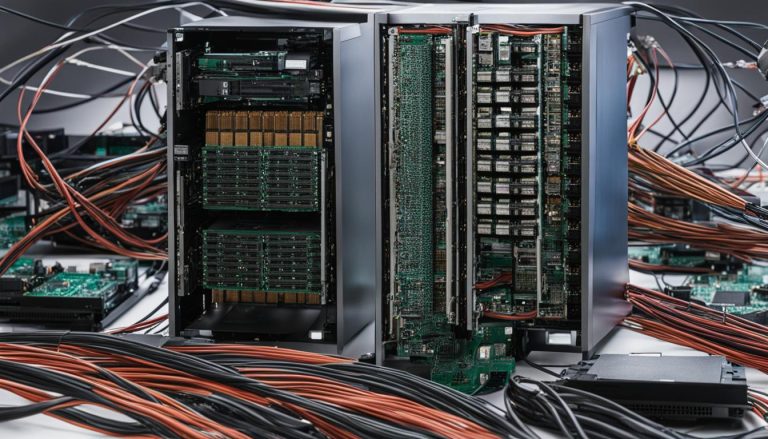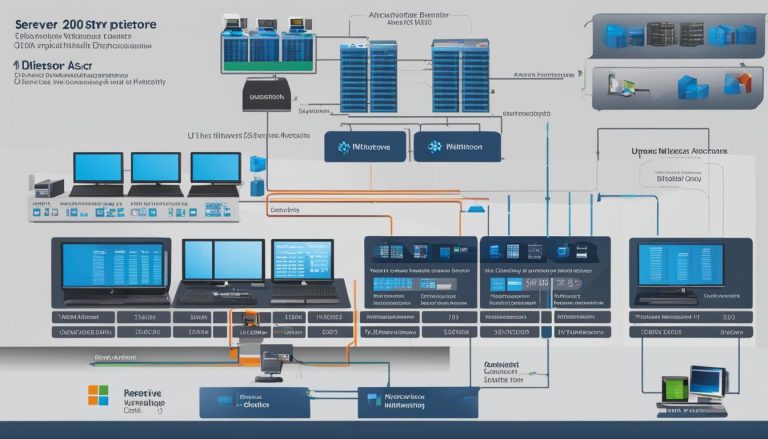Windows Server 2003 R2 is an operating system developed by Microsoft that provides enhanced features and capabilities compared to its predecessor, Windows Server 2003. Designed for managing servers and delivering services to clients, Windows Server 2003 R2 offers improved security, reliability, availability, and ease of administration.
In this article, I will delve into the key aspects of Windows Server 2003 R2, including its definition, features, and benefits for organizations. So let’s dive in and explore the world of Windows Server 2003 R2.
Key Takeaways:
- Windows Server 2003 R2 is an operating system developed by Microsoft.
- It offers enhanced security, reliability, availability, and ease of administration.
- Windows Server 2003 R2 supports both 32-bit and 64-bit architectures.
- Key features include Active Directory, Terminal Services, and support for virtualization.
- Upgrading to a newer and supported version is recommended after its end of life.
Understanding the Windows Server 2003 Family
The Windows Server 2003 family consists of various editions that cater to different needs and usage scenarios. These editions include the Web Edition, Standard Edition, Enterprise Edition, and Datacenter Edition. Each edition offers a unique set of features and capabilities, allowing organizations to choose the one that best suits their requirements.
The Web Edition is designed specifically for web services, providing a lightweight and cost-effective solution. It is ideal for organizations that primarily focus on hosting websites and web applications.
The Standard Edition provides a robust set of features for small to medium-sized businesses. It offers enhanced reliability, security, and management capabilities, making it suitable for a wide range of general-purpose server applications.
The Enterprise Edition is targeted at medium to large-sized businesses, offering advanced features such as support for multiple processors, increased memory capacity, and clustering. It provides scalability and high availability, making it suitable for critical enterprise applications.
The Datacenter Edition is designed for high-performance and scalability, providing support for large-scale deployments with significant memory and processing capabilities. It offers advanced features like hot-add memory and processor support, making it ideal for mission-critical applications that require maximum performance and reliability.
Table: Windows Server 2003 Editions Comparison
| Edition | Target Audience | Key Features |
|---|---|---|
| Web Edition | Organizations focused on web services | Lightweight, cost-effective, web hosting capabilities |
| Standard Edition | Small to medium-sized businesses | Enhanced reliability, security, and management features |
| Enterprise Edition | Medium to large-sized businesses | Support for multiple processors, increased memory capacity, clustering |
| Datacenter Edition | High-performance, large-scale deployments | Hot-add memory and processor support, maximum performance and reliability |
When installing Windows Server 2003 R2, it is important to ensure that the system meets the necessary requirements. These requirements include a compatible processor, sufficient memory, and available disk space. The installation process involves configuring a computer to function as a domain controller in an Active Directory domain, enabling centralized management of network resources and user accounts.
Understanding the different editions of the Windows Server 2003 family and their respective features is essential for organizations to make informed decisions about which edition is most suitable for their specific needs.
Key Enhancements in Windows Server 2003 R2
Windows Server 2003 R2 introduced several key enhancements compared to the original Windows Server 2003 release, making it a significant upgrade for organizations. One of the major enhancements was the inclusion of Service Pack 1 (SP1). This service pack brought numerous improvements to the operating system, enhancing its security, stability, and functionality.
With the integration of security updates, Windows Server 2003 R2 became more resilient against potential threats. It introduced new features like Windows Firewall, which provided an additional layer of protection for the server. The Post-Setup Security Updates (PSSU) ensured that the latest security patches were applied during the installation process, reducing vulnerabilities right from the start. Moreover, the Security Configuration Wizard (SCW) allowed administrators to easily manage security settings and policies, strengthening the overall security posture of the server.
In addition to security enhancements, Windows Server 2003 R2 also focused on improving management capabilities. It offered enhanced server management for branch offices, allowing organizations to efficiently manage distributed environments. The simplified storage configuration made it easier for administrators to allocate and manage storage resources effectively. The support for high-performance web applications enabled organizations to deliver faster and more responsive web services to their clients. Lastly, Windows Server 2003 R2 introduced cost-effective server virtualization, enabling organizations to consolidate their server infrastructure and reduce hardware and operational costs.
Overall, Windows Server 2003 R2 provided a significant upgrade over its predecessor, offering enhanced security, management capabilities, and performance improvements. These enhancements expanded the capabilities of Windows Server 2003 R2, empowering organizations to build more secure, efficient, and scalable server environments.
Key Enhancements in Windows Server 2003 R2:
| Enhancement | Description |
|---|---|
| Service Pack 1 (SP1) | Enhanced security with integrated security updates, Windows Firewall, Post-Setup Security Updates (PSSU), and Security Configuration Wizard (SCW). |
| Improved Server Management | Enhancements for managing servers in branch offices, simplified storage configuration, and support for high-performance web applications. |
| Cost-Effective Server Virtualization | Support for server virtualization, enabling organizations to consolidate their server infrastructure and reduce costs. |
Editions of Windows Server 2003 R2
Windows Server 2003 R2 is available in different editions, each designed to meet specific requirements and cater to various use cases. Understanding the differences between these editions is crucial for organizations to select the one that best suits their needs. Let’s explore the editions of Windows Server 2003 R2 in detail:
Web Edition
The Web Edition of Windows Server 2003 R2 is specifically tailored for hosting web services and applications. It provides a lightweight and cost-effective solution for organizations that primarily focus on web-related activities. While it offers fewer features compared to other editions, it still provides essential functionality for web hosting.
Standard Edition
The Standard Edition of Windows Server 2003 R2 is suitable for small to medium-sized businesses. It offers a robust set of features, including support for Active Directory, file and print services, and remote access. This edition is ideal for organizations that require essential server capabilities without the need for advanced functionality.
Enterprise Edition
Designed for medium to large-sized businesses, the Enterprise Edition of Windows Server 2003 R2 offers advanced features and scalability. It supports multiple processors, increased memory capacity, and features like clustering, making it suitable for organizations that require higher performance and reliability.
Datacenter Edition
The Datacenter Edition of Windows Server 2003 R2 is specifically designed for high-performance and scalability. It supports large-scale deployments with extensive memory and processing capabilities. This edition is ideal for organizations that require maximum performance and reliability for mission-critical applications and services.
| Edition | Target Market | Key Features |
|---|---|---|
| Web Edition | Web hosting | Lightweight, cost-effective, web-focused features |
| Standard Edition | Small to medium-sized businesses | Essential server capabilities, Active Directory, remote access |
| Enterprise Edition | Medium to large-sized businesses | Advanced features, multiple processors, clustering |
| Datacenter Edition | High-performance environments | Scalability, extensive memory and processing capabilities |
By understanding the differences between the editions of Windows Server 2003 R2, organizations can make informed decisions about which edition aligns with their specific requirements, ensuring they have the right set of features and functionality to meet their server needs.
Lifecycle and Support for Windows Server 2003 R2
Windows Server 2003 R2 reached its end of life on July 14, 2015. This means that Microsoft no longer provides regular updates, security patches, or support for the operating system. It is important for organizations still using Windows Server 2003 R2 to consider upgrading to a newer and supported version to ensure security and compatibility.
Upgrading to a newer version of Windows Server may require careful planning and preparation. Factors such as hardware compatibility, application compatibility, and migration of data and settings need to be considered. It is recommended to consult Microsoft’s resources and guidance to help with the upgrade process and to ensure a smooth transition.
By upgrading to a newer version of Windows Server, organizations can take advantage of the latest features, security updates, and support provided by Microsoft. This ensures the ongoing stability and functionality of their server infrastructure, allowing them to stay protected against modern threats and take advantage of the latest advancements in server technology.
Resources for Windows Server 2003 R2 Upgrade:
- Official Microsoft documentation and support forums
- Third-party migration tools and services
- Consulting services for planning and executing the upgrade
Benefits of Upgrading:
1. Security: Upgrading to a supported version ensures access to regular security updates and patches, keeping your server infrastructure protected against emerging threats.
2. Compatibility: Newer versions of Windows Server offer improved compatibility with modern hardware and software applications, allowing you to leverage the latest technologies.
3. Performance: Upgrading to a newer version can provide performance optimizations and enhancements, enabling your servers to handle increased workloads more efficiently.
4. Support: By upgrading, you gain access to Microsoft’s support network, allowing you to receive assistance and guidance when encountering issues or challenges during the upgrade process.
| Windows Server 2003 R2 Edition | End of Life Date |
|---|---|
| Web Edition | July 14, 2015 |
| Standard Edition | July 14, 2015 |
| Enterprise Edition | July 14, 2015 |
| Datacenter Edition | July 14, 2015 |
Conclusion
After exploring the features and enhancements of Windows Server 2003 R2, it is clear that this operating system was a significant release in the Windows Server family. With improved security, reliability, and manageability, Windows Server 2003 R2 provided organizations with the tools they needed to efficiently manage their server infrastructure.
However, it is important to note that Windows Server 2003 R2 has reached its end of life. Microsoft no longer provides regular updates, security patches, or support for this operating system. Therefore, it is highly recommended that organizations still using Windows Server 2003 R2 upgrade to a newer and supported version.
By upgrading to a newer version of Windows Server, organizations can take advantage of the latest features, security updates, and support from Microsoft. This ensures the ongoing stability and functionality of their server infrastructure. Upgrading may require careful planning and preparation, but the benefits outweigh the challenges.
FAQ
What is Windows Server 2003 R2?
Windows Server 2003 R2 is an operating system developed by Microsoft that includes various enhancements and additional features compared to the original Windows Server 2003 release.
What are the main editions of Windows Server 2003 R2?
The main editions of Windows Server 2003 R2 are Web Edition, Standard Edition, Enterprise Edition, and Datacenter Edition.
What are some key features of Windows Server 2003 R2?
Some key features of Windows Server 2003 R2 include improved security, reliability, availability, and ease of administration. It also supports both 32-bit and 64-bit architectures and provides features like Active Directory, Terminal Services, and support for virtualization.
How does Windows Server 2003 R2 differ from the original Windows Server 2003 release?
Windows Server 2003 R2 introduces several enhancements compared to the original Windows Server 2003 release, including the inclusion of Service Pack 1 (SP1) for enhanced security, improved management of servers in branch offices, enhanced identity management, simplified storage configuration, support for high-performance web applications, and cost-effective server virtualization.
What are the different editions of Windows Server 2003 R2?
Windows Server 2003 R2 is available in different editions, including Web Edition, Standard Edition, Enterprise Edition, and Datacenter Edition, each designed for specific use cases.
When did Windows Server 2003 R2 reach its end of life?
Windows Server 2003 R2 reached its end of life on July 14, 2015, which means Microsoft no longer provides regular updates, security patches, or support for the operating system.
Is it recommended to upgrade from Windows Server 2003 R2?
Yes, it is highly recommended for organizations still using Windows Server 2003 R2 to upgrade to a newer and supported version of Windows Server to ensure security and compatibility.
What are some considerations for upgrading to a newer version of Windows Server?
Upgrading to a newer version may require careful planning and preparation, considering factors like hardware compatibility, application compatibility, and migration of data and settings.
What support does Microsoft offer for newer versions of Windows Server?
Microsoft provides resources and guidance to help organizations with the upgrade process and offers support for the newer versions of Windows Server.
What are the benefits of upgrading to a newer version of Windows Server?
By upgrading, organizations can take advantage of the latest features, security updates, and support from Microsoft, ensuring the ongoing stability and functionality of their server infrastructure.
Janina is a senior specialist in information technology


